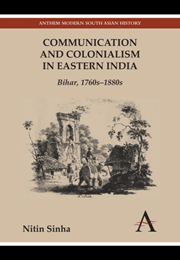Book contents
- Frontmatter
- Contents
- Acknowledgements
- List of Abbreviations
- Glossary
- List of Tables and Illustrations
- Introduction
- Chapter 1 From Affective Forms to Objectification: Spatial Transition from Pre-colonial to Colonial Times
- Chapter 2 India and its Interiors
- Chapter 3 Going into the Interiors
- Chapter 4 Knowing the Ways
- Chapter 5 Controlling the Routes
- Chapter 6 Changing Regime of Communication, 1820s–60s
- Chapter 7 Of Men and Commodities
- Chapter 8 The Wheels of Change
- Conclusion
- Bibliography
- Index
- Frontmatter
- Contents
- Acknowledgements
- List of Abbreviations
- Glossary
- List of Tables and Illustrations
- Introduction
- Chapter 1 From Affective Forms to Objectification: Spatial Transition from Pre-colonial to Colonial Times
- Chapter 2 India and its Interiors
- Chapter 3 Going into the Interiors
- Chapter 4 Knowing the Ways
- Chapter 5 Controlling the Routes
- Chapter 6 Changing Regime of Communication, 1820s–60s
- Chapter 7 Of Men and Commodities
- Chapter 8 The Wheels of Change
- Conclusion
- Bibliography
- Index
Summary
This book in no way claims to represent the ‘right’ way of writing the history of communication. There could, and possibly do, exist many other ways in which this theme can be approached. I will use this conclusion to broadly reflect on the general outcome of this research but also on the possibilities of further ‘opening up’ the theme of communication in diverse directions.
One of the possible ways in which this account could be rewritten is by enlarging the field and scope of enquiry by including post and telegraph, which was introduced in roughly the same period as more focused debates on good roads, and later the railways, began to emerge, that is, in the 1830s. Roads, railways, and post and telegraph constituted the triumvirate of the new technological basis of ‘communication’ in colonial India. That the dak system had existed long before is undisputable, but the technological spread of services of postal and telegraphic communication that catered to a wider social base constitutes a fascinating area of research. In what ways this new technology fostered new types of mobilities and sociabilities by enabling migrant workers to remit money back home is one example in which the social and economic impulses of the nineteenth century can be understood through the intervention of technology. More conventionally, the role of the dissemination of telegraphic command in the consolidation of colonial rule would prove useful in understanding the techniques of governmentality that the colonial state promoted from the mid-nineteenth century.
- Type
- Chapter
- Information
- Communication and Colonialism in Eastern IndiaBihar, 1760s-1880s, pp. 233 - 240Publisher: Anthem PressPrint publication year: 2012



